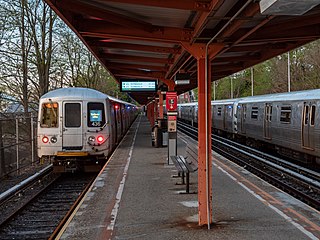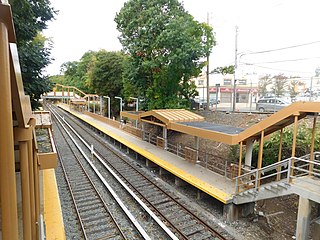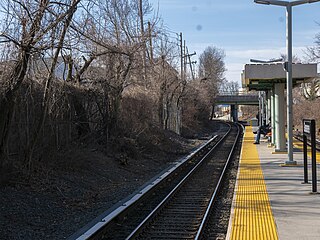
The Staten Island Railway (SIR) is a rapid transit line in the New York City borough of Staten Island. It is owned by the Staten Island Rapid Transit Operating Authority (SIRTOA), a subsidiary of the Metropolitan Transportation Authority, and operated by the New York City Transit Authority Department of Subways. SIR operates 24 hours a day, seven days a week, providing local service between St. George and Tottenville, along the east side of the island. There is currently only one line on the island, and there is no direct rail link between the SIR and the New York City Subway system, but SIR riders do receive a free transfer to New York City Transit bus and subway lines, and the line is included on official New York City Subway maps. Commuters on the railway typically use the Staten Island Ferry to reach Manhattan. The line is accessible from within the Ferry Terminal, and most of its trains are timed to connect with the ferry. In 2023, the system had a ridership of 6,151,400, or about 19,500 per weekday as of the fourth quarter of 2023.

The Bay Ridge–95th Street station is the southern terminal station on the BMT Fourth Avenue Line of the New York City Subway. Despite the name, the station is located in the neighborhood of Fort Hamilton at the intersection of 95th Street and Fourth Avenue in southwestern Brooklyn. It is served by the R train at all times. Geographically, this station is the westernmost New York City Subway station.

The Tottenville station is a Staten Island Railway rapid transit station in the neighborhood of Tottenville, Staten Island, New York City. Located near Main Street and Arthur Kill Road, it is the southern terminus on the main line and the southernmost railway station in both New York City and New York State.

Atlantic was a Staten Island Railway station in the neighborhood of Tottenville, Staten Island, New York. With the condition of the station having deteriorated after the 1990s, this station, and the Nassau station to the north, were replaced by a new station at Arthur Kill Road. When that station opened in January 2017, Atlantic station closed and subsequently demolished.

The Nassau station was a Staten Island Railway station located roughly between the neighborhoods of Tottenville and Charleston, in Staten Island, New York. The station was built sometime after 1924 in order to serve the Nassau Smelting & Refining Company, and had a siding so that freight could be transferred to and from the factory. The station platforms were extended in 1971 as part of the modernization of the rail line. However, the condition of the station deteriorated after the 1990s, and this station, along with the Atlantic station to the south, were replaced by a new station at Arthur Kill Road. When that station opened in January 2017, Nassau station closed. The station was subsequently demolished.

The Pleasant Plains station is an elevated Staten Island Railway station in the neighborhood of Pleasant Plains, Staten Island, New York.

The Prince's Bay station is a Staten Island Railway station in the neighborhood of Prince's Bay, Staten Island, New York.

The Huguenot station is a Staten Island Railway station in the neighborhood of Huguenot, Staten Island, New York.

The Annadale station is a Staten Island Railway station in the neighborhood of Annadale, Staten Island, New York.

The Grasmere station is a Staten Island Railway station in the neighborhood of Grasmere, Staten Island, New York. It is located at Clove Road on the Main Line.

The Clifton station is a Staten Island Railway station in the neighborhood of Clifton, Staten Island, New York. This station was the original terminal of the Staten Island Railway from 1860 until 1886. The station was known as Vanderbilt's Landing, and was used as a transfer point for passengers going to Manhattan via ferries to South Ferry.
Cedar Avenue was a station on the demolished South Beach Branch of the Staten Island Railway. It had two tracks and two side platforms and was located at Cedar Avenue and Railroad Avenue. It opened in 1931, and closed in 1953.

The Sailors' Snug Harbor station is a former station on the abandoned North Shore Branch of the Staten Island Railway. It had two tracks and two side platforms. Located in the Livingston section of Staten Island north of Richmond Terrace, the station was approximately 1.2 miles (1.9 km) from Saint George Terminal. It is at the northernmost end of the Snug Harbor Cultural Center and Botanical Garden.

Port Richmond is a station on the abandoned North Shore Branch of the Staten Island Railway. Located in Port Richmond on a concrete trestle at Park Avenue and Church Street, it has two tracks and an island platform. The station is located approximately 3 miles (4.8 km) from Saint George Terminal.
Harbor Road was a station on the abandoned North Shore Branch of the Staten Island Railway in Mariners Harbor, Staten Island, New York. The station, located under the overpass at the highest point of Harbor Road, was built in an open-cut with two tracks and one island platform. It was located 4.9 miles (7.9 km) from the Saint George terminal. The station was opened during the SIRT grade crossing elimination project of 1935 – 1937. It closed on March 31, 1953, along with the South Beach Branch and the rest of the North Shore Branch. The station was demolished in 2004 during a reconstruction of the rail system for reactivated freight service by the nearby Howland Hook Marine Terminal.

Tower Hill is a station on the abandoned North Shore Branch of the Staten Island Railway, located in Tower Hill between the Port Richmond and Elm Park neighborhoods. The station lies between Treadwell and Sharpe Avenues about 3.4 miles (5.5 km) from the Saint George Terminal, with two tracks and an island platform. It is one of the three best-preserved stations on the line, the other two being Port Richmond and the line's western terminus at Arlington, in Mariners Harbor.
The Mount Loretto Spur is an abandoned branch of the Staten Island Railway whose purpose was to serve the Mount Loretto Children's Home.

The North Shore Branch is an abandoned branch of the Staten Island Railway in New York City, which operated along Staten Island's North Shore from Saint George to Port Ivory. The line continues into New Jersey via the Arthur Kill Vertical Lift Bridge to Aldene Junction in Cranford.

The Staten Island Railway (SIR) is the only rapid transit line in the New York City borough of Staten Island and is operated by the Staten Island Rapid Transit Operating Authority, a unit of the Metropolitan Transportation Authority. The railway was historically considered a standard railroad line, but today only the western portion of the North Shore Branch, which is disconnected from the rest of the SIR, is used by freight and is connected to the national railway system.

















